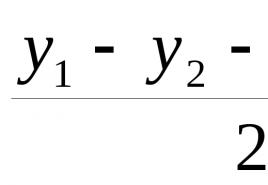Chronology of ancient greece. Ancient greece calendar
It was a lunisolar calendar with primitive and irregular intercalation rules. From about 500 BC spread octateria (octaeteris) - 8-year cycles in which five regular years of 12 months were combined with three years of 13 months. Subsequently, these rules were adopted by the Roman calendar. Octateria in Greece continued to be used even after the reform of Julius Caesar.
The beginning of the year was in the middle of summer.
Athenian months:
|
12. Scirophorion |
Chronology
In the second half of the 3rd century BC. e. the ancient Greek historian Timaeus (about 352 - 256 BC) and the mathematician Eratosthenes (about 276 - about 196 BC, Eratosthenes is considered the father of chronology, he owns the idea of \u200b\u200ba unified system of counting years) the chronology was introduced first Olympic Games. The games were held once every four years on days close to the summer solstice. They began on the 11th and ended on the 16th day after the new moon. When counting years in the Olympiads, each year was designated by the ordinal number of the games and the number of the year in the fourth year. The first Olympic Games opened on July 1, 776 BC. according to the Julian calendar. In 394 A.D. Emperor Theodosius I banned the Olympic Games. The Romans called them “ otium graecum”(Greek idleness). However, the chronology of the Olympiads remained for some time.
Greek and Egyptian astronomy
It should be noted the following fact, which, of course, influenced the development of the European calendar. During the era of Alexander the Great and the Seleucids, Egypt became part of the Greek world. Alexandria is founded in Egypt, which becomes the greatest center of ancient science and astronomy. It was the Greek Alexandrian astronomers who developed the Julian calendar. In Alexandria, the calculations of the first Paschal of the Christian calendar were carried out; Ptolemy Claudius (2nd century AD) worked here, who wrote the "Almagest", an outstanding work that influenced the formation of all modern astronomy.
Despite their knowledge of astronomy, the Greeks used their imperfect calendar for a long time, with calendars differing in different parts of the Greek world.
from the deities or such festivals that took place during these months. Finally, it should also be noted that in many states the priests or magistrates for worship were the eponyms of the year. All this indicates a close connection in which the time reckoning of the Greeks stood with their religious institutions, and this connection from ancient times forced them to pay great attention to the exact regulation of time reckoning.
It goes without saying that the improvement of the calendar proceeded slowly, with the gradual development of astronomical and mathematical knowledge. In ancient times, they were content, especially in agricultural life, with approximate definitions of the time of the ascent and entry of heavenly bodies, the state of vegetation, the flight of birds, and so on. Hesiod advises to begin the harvest at the rise of the Pleiades, plowing - at their entry (Works and Days, 383), or when the cry of the cranes will be heard (v. 448). Already Homer's poems repeatedly mention the years (Ill. II, 329; Od. II, 175, etc.). Since the course and phases of the moon are very easily observable and, first of all, should have attracted attention, the chronology of the lunar months and years came into general use among the Greeks and, with very few exceptions, survived until the time of Christianity.
The lunar or synodic month (from new moon to new moon) has 29 days. 12 hours 44 minutes 3 seconds, therefore, the lunar year consists of 354 days. 8 h. 48 min. 36 sec. and differs from the solar one (comprising 365 days, 5 hours 48 minutes and 17.8 seconds) by 10 days and 21 hours without a few seconds. But the exact calculation of minutes and seconds with imperfect means of observation could be done only very slowly, over many centuries. Initially, they were content with an approximate definition of the lunar month at 29 or 30 days and the lunar year at 354 days, but this year lagged behind the solar one so much that after a short period of time the months and holidays would no longer correspond to the seasons in which they originally fell. Therefore, the need arose to find ways of possibly exact matching or equations of the lunar years with the solar ones, and this question occupied Greek astronomers for many centuries. The usual method of agreement was that from time to time, the thirteenth intercalary month (mhn embolimoV) was added to the ordinary lunar year, so that the year then had 384 days. Initially, this month was added to every third year (triethriV). A somewhat more accurate way of equation is attributed to the Athenian legislator Solon (Plut. Sol. 25; Tsen-
The astronomical thought of the ancient Greeks from distant eras developed in the scheme of the lunisolar calendar; the days in civilian life were counted along the moon, from new moon to new moon; their calendar numbers thus showed only the age of the moon. But with that scientific realism that characterizes Greek culture, with that heartfelt "surprise" with which the Greeks approached nature, they quickly learned that astronomical observations should reveal the connection between the phenomena of the starry sky and the movement of the Sun and that the calendar should reflect this connection. From the VIII century. BC e. they knew the eight-year period (octoetheteris) - a very primitive instrument, as we know. By the time of Solon the legislator (about the 6th century BC), the corrected octoetheteride was already in effect in Attica; each period was lengthened by ½ day. Therefore, from two such periods it turned out:
2.922 2 + 3 \u003d 5.847 days \u003d 198 lunar months \u003d 16 solar years.
This ratio gives quite an acceptable result for the Moon; but the solar year comes out equal to a day, that is, one day more than the Julian year. Consequently, for every 16 years of the solstice - the year for the ancient Greeks began with the summer solstice - they shifted in the calendar 3 days ago; the error is obvious, even with all the difficulty of the corresponding observations. But already in the V century. Meton has made significant improvements. “This man has achieved the truth regarding the prediction of the phenomena of the starry sky, for the movements of the stars and changes in the weather are quite consistent with his data; therefore, until my time, most Greeks use its 19-year circle, ”wrote the historian Diodorus in the 1st century BC. BC e. That meteorological, or climatological, predictions were made by the ancient Greeks in parallel with astronomical predictions is one of the characteristic features of their general worldview, their knowledge of nature was based on purely observational material, without any admixture of astrology. In what calendar form was it clothed?
The annual circle of the Sun is divided into 12 equal parts (dodecatemoria), into 12 signs of the Zodiac; the origin of this division is a special, very complex question that does not interest us now; for the ancient observer it was essential that the change of annual rising and setting of stars and - he thought - changes in the weather (epistemasia) occur at certain moments of the Sun's passage through its circle; therefore, zodiacal tables are constructed from observations, in which both phenomena are described according to 12 signs. It is clear that such tables are sufficient for 365 days of the year; then it only remains to reconcile them with the counting of days in the civil lunar year and make this data publicly available - Greek science was never locked in temples and was not caste. To observe the solstices, Meton erected his steles (columns) and instruments on Pnyx in Athens, at the very square of popular assemblies, and everyone could resolutely see his parapegmas, that is, calendars carved in stone.
For a long time archaeologists did not understand how these calendars could have been arranged; after all, one cannot put on a stone 6.940 dates of the 19-year circle, repeating 19 rounds of the Sun in all the signs of the Zodiac. Only in 1902, during the excavations of the theater in Miletus (in Asia Minor), were the fragments of such a parapegma found; they immediately revealed an ingenious solution to this technical problem, found by the Greeks. In fig. 9 shows one of the fragments of the monument; it shows a number of inscriptions arranged in rows; to the left of the lines, as well as between them, there is a series of small holes; there are 30 of them on the right column - which is shown above by the Greek letter Λ; Let us number all these holes, putting down numbers in front of the lines, which are not on the monument.

Figure: 9. Ancient Greek permuted calendar
In translation, the inscriptions read as follows:
1 ♦ Sun in Aquarius
2 ♦ The lion begins to enter at dawn and Lyra enters
5 ♦ The swan sets at dawn
♦ ♦ ♦ ♦ ♦ ♦ ♦ ♦ ♦
15 ♦ Andromeda begins to rise in the morning at dawn
18 ♦ Aquarius's middle rises
19 ♦ Pegasus begins to rise in the morning at dawn
21 ♦ Centaurus sets in entirely in the morning
22 ♦ Hydra comes in full in the morning
23 ♦ Whale enters at dawn
24 ♦ The arrow comes in, it's time for Zephyr (spring) leading
29 ♦ The whole swan sets in at dawn
30 ♦ [Arcturus] rises at dawn
We see that this is a perfectly preserved zodiac table for 1 month, precisely at the time the Sun passes the sign of Aquarius. In our modern calendar, the Sun enters this sign (300 ° longitude) around January 22; from here it would be easy, using the numbers in front of the lines, to determine the calendar dates of all the other predicted phenomena. But now we must completely forget this solar dating; the Greeks did not know her. In their lunar calendar, the entry of the Sun into any of the signs jumped from date to date according to the years of the circle, as shown in 6. The eight-year period and the methonic circle, type A. But here holes in the stone come to the rescue: if you know what date of the lunar calendar The sun in a given year enters the first sign, then it is enough to put pins with consecutive dates in all the holes both at the lines and between the lines, alternating months by 29 and 30 days according to the rules of the lunar calendar; then each of the rows of the table, that is, each phenomenon, will fall on a completely definite date of the lunar year; everyone will see at once on what numbers important and interesting natural phenomena will fall. This is how they finally found out the previously mysterious meaning of the word parapegma and its connection with the verb meaning "to attach", "to work in." It was a popular calendar.
The question of the internal structure of the Metonian circle among the Greeks has not yet been finally resolved by chronologists; for 19 years, 7 embolismic months must be inserted (12 12 + 7 13 \u003d 235); the ancients did not leave any precise description of the structure of the cycle in relation to the order of their placement. It is now commonly believed that 3, 6, 9, 12, 15, 17 and 19 years of the circle were embolismic. Taking into account that the average solar year in this system is equal to a month, the reader can easily construct a table of error distribution for the beginning of each of the lunar years, as was done for the 8-year period or for the free lunar calendar.
The introduction of the Metonian circle is associated with the famous astronomical observation reported by Ptolemy: "The summer solstice observed by Meton and Euctemon is recorded in the records of the Athenian archon Aseis, on the 21st day of the Egyptian month Famenot in the morning." The translation of the dating and historical data very accurately determine the day of observation: it is June 27, 432 BC. e. But from the table of equinoxes it is easy to verify that the solstice was 432, June 28, at 2 o'clock, counting the day from noon, Athenian time (Athens is 1½ hours east of Greenwich). Consequently, Meton's observation is wrong by no more than 1½ days - a good result for that era. The first day of the first Metonian circle is set on the first neomeny after this solstice, which gives July 16, 432 BC. e., following most of the chronologists.
Initially, the various Greek centers had their own time systems, which led to a lot of confusion. This was due to the self-adjustment of the calendar in each policy. There were differences in the definition of the beginning of the calendar year.
The Athenian calendar is known, which consisted of twelve lunar months, the beginning of each of which approximately coincided with neomeny. The length of the months varied within 29-30 days, and the calendar year consisted of 354 days.
Since the true lunar year includes 354.36 days, the phases of the moon did not exactly correspond to the calendar dates to which they were assigned. Therefore, the Greeks distinguished the calendar "new moon", that is, the first day of the month and the actual new moon.
The names of the months in Greece were in most cases associated with certain holidays and only indirectly related to the seasons.
The beginning of the Athenian year fell on the month of Hecatombeon (July-August), associated with the summer solstice. To align the calendar year with the solar year, the 13th (embolismic) month, the 2nd Poseideon, was inserted in special years, lasting 29-30 days.
In 432 BC. The Athenian astronomer Meton developed a new 19-year cycle with seven embolismic years: 3rd, 6th, 8th, 11th, 14th, 17th and 19th. This order, called the Meton cycle, provided a fairly high accuracy. The discrepancy per day between the solar and lunar years accumulated over 312 solar years.
Later, the cycles of Calippus and Hipparchus were developed, further refining the lunisolar calendar. However, in practice, their amendments were hardly applied.
Until the II century. BC e. The 13th month was added as the need arose, and sometimes for political and other reasons.
The Greeks did not know the seven-day week and counted the days within a month for decades.
The events in Athens were dated by the names of the Archon officials. From the IV century. BC e. The chronology of the Olympiads, held once every four years, has become generally accepted.
The beginning of the era was considered the first Olympiad, held in the summer of 776 BC.
In the Hellenistic era, various eras were used in Greece: the era of Alexander, the era of the Seleucids, etc.
The official calendar, due to deviations from the solar year, was inconvenient for agriculture. Therefore, the Greeks often used a kind of agricultural calendar based on the apparent movements of the stars, on the change of seasons. He gave a detailed description of such a calendar in the form of advice to the farmer back in the 8th century. BC e. Hellenic poet Hesiod.
Such a folk calendar was of great practical importance and was preserved along with the official time count for many centuries of Greek history.







